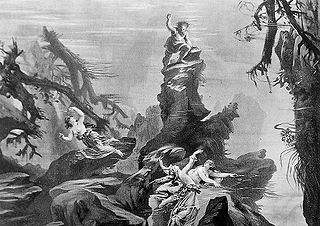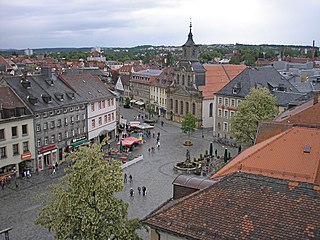
Das Rheingold, WWV 86A, is the first of the four epic music dramas that constitute Richard Wagner's Der Ring des Nibelungen. It premiered as a single opera at the National Theatre of Munich on 22 September 1869, and received its first performance as part of the Ring cycle at the Bayreuth Festspielhaus on 13 August 1876.

Bayreuth is a town in northern Bavaria, Germany, on the Red Main river in a valley between the Franconian Jura and the Fichtel Mountains. The town's roots date back to 1194. In the 21st century, it is the capital of Upper Franconia and has a population of 72,148 (2015). It hosts the annual Bayreuth Festival, at which performances of operas by the 19th-century German composer Richard Wagner are presented.

The Bayreuth Festspielhaus or Bayreuth Festival Theatre is an opera house north of Bayreuth, Germany, built by the 19th-century German composer Richard Wagner and dedicated solely to the performance of his stage works. It is the venue for the annual Bayreuth Festival, for which it was specifically conceived and built. Its official name is Richard-Wagner-Festspielhaus. It is the home of the Bayreuth Festival Orchestra.

The Bayreuth Festival is a music festival held annually in Bayreuth, Germany, at which performances of stage works by the 19th-century German composer Richard Wagner are presented. Wagner himself conceived and promoted the idea of a special festival to showcase his own works, in particular his monumental cycle Der Ring des Nibelungen and Parsifal.

Princess Friederike Sophie Wilhelmine of Prussia was a Prussian princess and composer. She was the eldest daughter of Frederick William I of Prussia and Sophia Dorothea of Hanover, and a granddaughter of George I of Great Britain. She was the older sister of Frederick the Great. In 1731, she married Frederick, Margrave of Brandenburg-Bayreuth. The baroque buildings and parks built during her tenure shape much of the present appearance of the town of Bayreuth, Germany.

The Principality of Bayreuth or Margraviate of Brandenburg-Bayreuth was an immediate territory of the Holy Roman Empire, ruled by a Franconian branch of the Hohenzollern dynasty. Since Burgrave Frederick VI of Nuremberg was enfeoffed with the Margraviate of Brandenburg in 1415/17, the Hohenzollern princes transferred the margravial title to their Franconian possessions, though the principality never had been a march. Until 1604 they used Plassenburg Castle in Kulmbach as their residence, hence their territory was officially called the Principality of Kulmbach or Margraviate of Brandenburg-Kulmbach until the Empire's dissolution in 1806.

Carl Philipp Christian von Gontard was a German architect who worked primarily in Berlin, Potsdam, and Bayreuth in the style of late Baroque Classicism. Next to Knobelsdorff, he was considered the most important architect of the era of Frederick the Great of Prussia.

The Zurich Opera House is an opera house in the Swiss city of Zurich. Located at the Sechseläutenplatz, it has been the home of the Zurich Opera since 1891, and also houses the Bernhard-Theater Zürich. It is also home to Ballett Zürich.

George William of Brandenburg-Bayreuth was a member of the House of Hohenzollern and Margrave of Brandenburg-Bayreuth.

Frederick (Friedrich) Margrave of Brandenburg-Bayreuth, was a member of the House of Hohenzollern and Margrave of Brandenburg-Bayreuth.

Princess Elisabeth Friederike Sophie of Brandenburg-Bayreuth, was a German princess of the House of Hohenzollern and the Duchess of Württemberg by marriage.

Renato Mismetti is an Italian-Brazilian baritone.

Opernhaus Wuppertal is a German theatre in Wuppertal, North Rhine-Westphalia. It houses mostly performances of operas, but also plays, run by the municipal Wuppertaler Bühnen. The house is also the venue for dance performances by the Tanztheater Wuppertal company created by Pina Bausch.

The Main Cycleway is a major German bicycle path running for about 600 km along the River Main in Germany. It starts from either Creußen or Bischofsgrün and ends in Mainz. The General German Bicycle Club (ADFC) rated the trail five stars in 2008, the first path in Germany to receive this award. Approximately 90% of the path is paved and 77% of the route is at least 2.5 metres wide.
Hans Wallat was a German conductor, GMD in Bremen, at the Nationaltheater Mannheim, Theater Dortmund and Deutsche Oper am Rhein. A specialist for the stage works of Richard Wagner, he appeared at the Bayreuth Festival and internationally.
Johann Pfeiffer was a German violinist, concert master and composer of the late baroque period.
Matthias von Stegmann is a German actor, voice-over speaker and writer, author and stage director for theatre and especially opera who works internationally. He wrote dialogue and directed it for German versions of American series such The Simpsons. In opera, he has focused on the work of Richard Wagner. He staged a version of his Der Ring des Nibelungen for children, first in Tokyo, then in German at the Vienna State Opera and in Zurich. He staged in 2012 Tristan und Isolde in Minden, and in 2013 the first performance of Rienzi at the Bayreuth Festival.

The Morettische Opernhaus was the most frequently performed opera house in Dresden from the end of the 18th century, in the era of Carl Maria von Weber and until the construction of the first Königliches Hoftheater Dresden.
The old palace is one of the two castles within the historic Hermitage Park to the east of the St. Johannis district of the German city of Bayreuth. The building should not be confused with the Old Palace in the city center.

Walter Kirchhoff was a German tenor who had an active international career in operas and concerts from 1906 through 1934. Prior to his career as an opera singer, he was a military officer in the cavalry division of the Imperial German Army. He later served Wilhelm, German Crown Prince as an adjutant during World War I while working as a resident artist at the Berlin Royal Opera where he had a lengthy performance career that spanned from 1906 through 1932. Kirchhoff was particularly celebrated for his performances in the operas of Richard Wagner. He sang leading roles at several prominent opera houses and festivals globally including the Bayreuth Festival, the Royal Opera House in London, the Teatro Colón, and the Vienna Court Opera. From 1926 to 1931 he was a leading tenor at the Metropolitan Opera in New York City. He finished his career as a resident artist at the Deutsches Opernhaus in 1933–1934. After retiring from the stage, he taught on the voice faculty of the Klindworth-Scharwenka Conservatory in Berlin, and was also active in that city as a theatre director and talent agent.

















